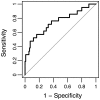Antibody response against cancer-testis antigens MAGEA4 and MAGEA10 in patients with melanoma
- PMID: 29928403
- PMCID: PMC6006456
- DOI: 10.3892/ol.2018.8684
Antibody response against cancer-testis antigens MAGEA4 and MAGEA10 in patients with melanoma
Abstract
Melanoma-associated antigen A (MAGEA) represent a class of tumor antigens that are expressed in a variety of malignant tumors, however, their expression in healthy normal tissues is restricted to germ cells of testis, fetal ovary and placenta. The restricted expression and immunogenicity of these antigens make them ideal targets for immunotherapy in human cancer. In the present study the presence of naturally occurring antibodies against two MAGEA subfamily proteins, MAGEA4 and MAGEA10, was analyzed in patients with melanoma at different stages of disease. Results indicated that the anti-MAGEA4/MAGEA10 immune response in melanoma patients was heterogeneous, with only ~8% of patients having a strong response. Comparing the number of strongly responding patients between different stages of disease revealed that the highest number of strong responses was detected among stage II melanoma patients. These findings support the model that the immune system is involved in the control of melanoma in the early stages of disease.
Keywords: antibodies; cancer; cancer-testis antigens; melanoma; melanoma antigens.
Figures





Similar articles
-
How the Intrinsically Disordered N-Terminus of Cancer/Testis Antigen MAGEA10 Is Responsible for Its Expression, Nuclear Localisation and Aberrant Migration.Biomolecules. 2023 Nov 24;13(12):1704. doi: 10.3390/biom13121704. Biomolecules. 2023. PMID: 38136576 Free PMC article.
-
Cancer-testis antigens MAGEA proteins are incorporated into extracellular vesicles released by cells.Oncotarget. 2019 Jun 4;10(38):3694-3708. doi: 10.18632/oncotarget.26979. eCollection 2019 Jun 4. Oncotarget. 2019. PMID: 31217903 Free PMC article.
-
Cancer-testis antigen expression in synovial sarcoma: NY-ESO-1, PRAME, MAGEA4, and MAGEA1.Hum Pathol. 2017 Mar;61:130-139. doi: 10.1016/j.humpath.2016.12.006. Epub 2016 Dec 16. Hum Pathol. 2017. PMID: 27993576
-
Cancer/Testis Antigens: Expression, Regulation, Tumor Invasion, and Use in Immunotherapy of Cancers.Immunol Invest. 2016 Oct;45(7):619-40. doi: 10.1080/08820139.2016.1197241. Epub 2016 Sep 7. Immunol Invest. 2016. PMID: 27603913 Review.
-
Strategies for the development of vaccines to treat breast cancer.Recent Results Cancer Res. 1998;152:94-102. doi: 10.1007/978-3-642-45769-2_9. Recent Results Cancer Res. 1998. PMID: 9928550 Review.
Cited by
-
The MAGE A1-A10 Expression associated with Histopathological Findings of Malignant or Non-Malignant Cells in Peripheral Lung Tumors.Asian Pac J Cancer Prev. 2023 Jul 1;24(7):2329-2335. doi: 10.31557/APJCP.2023.24.7.2329. Asian Pac J Cancer Prev. 2023. PMID: 37505763 Free PMC article.
-
Cancer testis antigen subfamilies: Attractive targets for therapeutic vaccine (Review).Int J Oncol. 2023 Jun;62(6):71. doi: 10.3892/ijo.2023.5519. Epub 2023 May 5. Int J Oncol. 2023. PMID: 37144487 Free PMC article. Review.
-
MAGEA4 Coated Extracellular Vesicles Are Stable and Can Be Assembled In Vitro.Int J Mol Sci. 2021 May 14;22(10):5208. doi: 10.3390/ijms22105208. Int J Mol Sci. 2021. PMID: 34069064 Free PMC article.
-
How the Intrinsically Disordered N-Terminus of Cancer/Testis Antigen MAGEA10 Is Responsible for Its Expression, Nuclear Localisation and Aberrant Migration.Biomolecules. 2023 Nov 24;13(12):1704. doi: 10.3390/biom13121704. Biomolecules. 2023. PMID: 38136576 Free PMC article.
-
Cancer-testis antigens MAGEA proteins are incorporated into extracellular vesicles released by cells.Oncotarget. 2019 Jun 4;10(38):3694-3708. doi: 10.18632/oncotarget.26979. eCollection 2019 Jun 4. Oncotarget. 2019. PMID: 31217903 Free PMC article.
References
-
- Chomez P, De Backer O, Bertrand M, De Plaen E, Boon T, Lucas S. An overview of the MAGE gene family with the identification of all human members of the family. Cancer Res. 2001;61:5544–5551. - PubMed
LinkOut - more resources
Full Text Sources
Other Literature Sources
Research Materials
